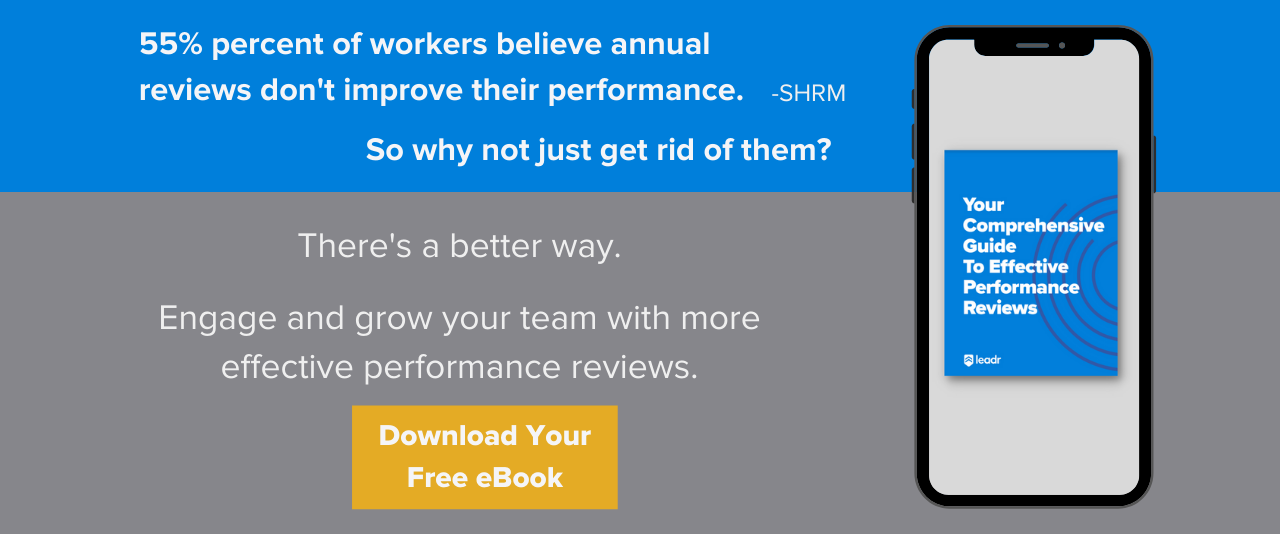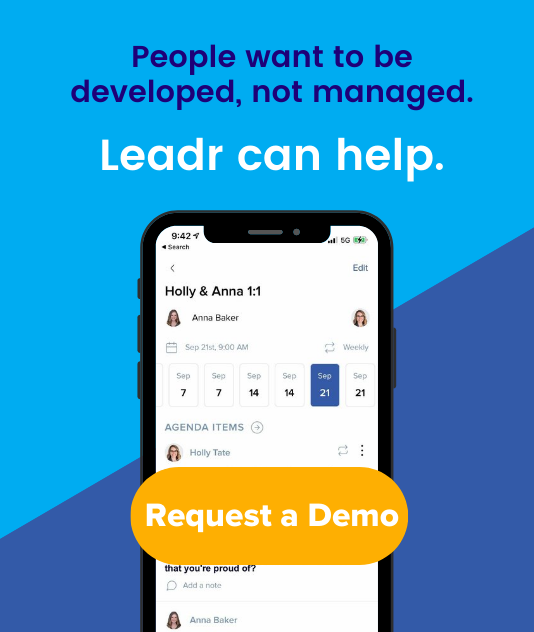Are Performance Reviews Outdated?
No matter what kind of jobs you’ve worked at - from a large corporate office job to a church plant to a bootstrapping startup - you’ve probably experienced the nerve-wracking stress of the performance review. Whether the pressure came from an expectation to set goals that you’d discuss with a supervisor to wondering if this could be a vague step in a future firing, performance reviews usually leave an odd cloud of negativity hanging over employees.
But the truth is, performance reviews should be a reflective meeting that inspires you and gives you the tools to achieve your goals, not scare you into it.
At Leadr, we think traditional performance reviews miss the mark - more often than not, they provide more confusion and anxiety for team members than insight into the value they bring to the team and how they can grow in the future.
If you go to a performance review at the end of the year, and you’re surprised by the conversation, there was a disconnect that happened somewhere earlier in the process. In fact, according to Gallup research, only 14 percent of employees strongly agree their performance reviews inspire them to improve.
And yet Gallup also found that on average, performance reviews cost $2.4 million to $35 million a year in lost working hours for an organization of 10,000 employees to take part in performance evaluations.
That’s a lot of money for companies to spend on outcomes that don’t enable growth - for the employee or the organization.
We think there’s a better way and the key is a focus on people development versus people management. Here’s what we mean by that.
Performance Reviews are Nothing New
Formal employee performance reviews have roots set in the Industrial Revolution - as ‘scaling up’ and machine-enabled mass production became prevalent, productivity arose as the most significant metric for understanding success and, ultimately, profitability. This necessitated a way to manage a team of workers and track progress.
Frederick Taylor’s turn-of-the-century foundational research on workplace design - also known as “Taylorism” where workers completed office work under the supervision of a boss - defined and standardized efficiency and productivity in large work environments such as manufacturing, warehousing, supply chains, department stores, and offices. Success was measured by how much work you could do and how well or fast you could do it.
Many years later, this is still too often the story at many organizations, simply because “it’s how we’ve always done it.”
In the past, performance reviews have been used to support a variety of outcomes. They, of course, can serve as documentation for employee contribution and behavior, although historically it seems that that documentation is mainly for areas of improvement, not a holistic look at a team member’s performance.
Performance reviews can also justify pay changes - good or bad - or promotion or termination decisions. Some employers also view the performance review meeting as a way to motivate better future output. Regardless of the outcome, performance review meetings are always documented to provide a record of the employee’s work and role in the organization.
A Different Way
1. We believe instead that performance reviews should be a piece of a larger conversation that is happening continuously.
Refocus your leadership and management efforts on recognizing the value your team brings to the organization, and providing the right opportunities and resources so they can improve, lead, and grow. You’ll see that the performance review naturally has to evolve. It will also help you refocus your leadership efforts less on numbers and more on people development, which will in turn improve efficiency. Success is a natural byproduct of great people development because your people power your mission.
That mindset is the basis of changing the way we do performance. Expectations for performance reviews should be adjusted to serve three distinct purposes: to guide, document, and support your people development.
2. Performance reviews should guide your team, just as you guide them as a leader.An annual performance review should be seen as an intentional effort to further build on the foundation of goal setting, direction, and guidance that you’ve established during one on ones throughout the year. By frequently reviewing and working on goals , your team members will feel confident, excited and inspired to meet with you at the end of the year to review how far they’ve come and where they could go next. Reflect on progress they’ve made and talk about areas of weakness or ways to improve - but focus this conversation on the future.
If feedback is a rhythm, your team members will have no surprises when they walk into their performance review.
Performance reviews should be one tool in your overall strategy to develop your team and guide them as they grow and improve in their role - not the only tool. In fact, if anything, the one on one meeting is your most important tool as a manager.
3. Performance reviews should be a tangible record of a year’s worth of work.A review should be more like a portfolio than the beginning of documentation for your team members. As you meet over the year, you should both keep a written record of conversations you’ve had. Where have things gone really well? What challenges have we faced and overcome? What work have you put into learning and growth? This is where you can reflect on an employee’s progress or lack of progress and share a recap of your thoughts during the performance review.
Reviews should function as a map of milestone moments, and an opportunity for both employees and managers to stop and reflect on past lessons learned and future goals.
But, one of the reasons Gallup notes that performance reviews make feedback more ineffective is because it often only comes when it’s too late. Feedback is more effective in the moment. Critical feedback on a problem way later during a performance review only rehashes the painful details on a likely already resolved issue. And praise offered only during a performance review leaves team members feeling overlooked during the rest of the year, thus the praise feels empty and less meaningful.
Giving a team member feedback when you see them doing something great - like operating in their strengths or taking steps to improve their processes for next time if a problem happens - is much more effective and meaningful when you provide it consistently and regularly. It gives your team a chance to improve over time without fear of termination (or it may prepare them for termination if that’s the outcome that is needed), and it reinforces that they are valued and seen for their unique strengths and skills.
Deloitte made the decision to evaluate and replace their system of annual performance reviews after discovering that their, “current approach to performance management, annual 360 feedback, was wasting a shocking 2 million hours per year.” As they evaluated how to improve this process, they found that their highest-performing teams were those who consistently reported the belief that
“I have the chance to use my strengths every day.”
So, when they began development of the new system, they kept the mission clear: “Spend more time helping people use their strengths.” The new system depends on weekly performance reviews, and the documentation comes in the form of a “Process Performance Snapshot,” a four-question form filled out by managers. The increased frequency is a big part of the new process, as the four indicators become part of a weekly score that employees can see, track, and act on.
Deloitte is just one of many organizations rethinking the way they conduct their performance reviews. We’ve gathered other organizations leading this change in our Comprehensive Guide To Effective Performance Reviews.
Performance reviews should create opportunities to increase rapport, clarity and maximization.
In our research, we found that the highest performing teams share three characteristics:
- Rapport: As a leader, you should strive to care about your team as people first. Whether we accept it or not, people come to work with their personal and professional priorities, so it’s wise to address your team members holistically. This might look like having caring conversations consistently in one on ones that communicate personal investment in their growth as well as what’s going on in their lives. Maybe it’s as simple as asking “what’s one way your prioritizing your needs this week?” or “How are you working to celebrate your accomplishments?” When you start from this mindset of overall growth, feedback is naturally built on a foundation of open and honest relationships and a culture of trust. Your team can trust that feedback is for their good, and for their future at the company.
- Clarity: It’s critical that your team understands the purpose and outcome of an annual review meeting and how it aligns with past, present, and future goals, results and expectations. When feedback is given regularly, it eliminates the confusion and miscommunication that can sometimes arise in an annual review because it is not new information. Your team should be excited to look back at what they’ve accomplished and how far they’ve come from overcoming challenges, and reflect on how they’ve taken feedback and used it to improve and grow. This helps them see how those experiences fit in both with their role on your team and their role in the overall big picture for the organization. This clarity is best refined in conversations and coaching - one on ones are essential.
- Maximization: As you meet with team members over the course of a year, help them envision a path forward and an end goal, and maximize the value they can bring to your team by putting them in “the right seat on the bus.” Where do they want to be this time next year? Next month? Next week?
Creating a plan for how they best fit in the organization - in the right role that maximizes their unique skills and strengths, helps them reach their personal goals, and serves the organization well - is one of the most valuable conversations you can begin and continuously have with team members, including during a review meeting.
Gallup notes that “A good manager, like a good coach, can see their employees from both an objective and subjective point of view. What is this person exceptionally good at? What do they care about most? What are their dreams and goals?
Effective coaching requires understanding an employee beyond their performance numbers and the limited observations made by managers -- and that means having real conversations.”
Seth Godin wisely asked, “What do you want to be doing 100 days from now? What change do you seek to be making? With which skills? Surrounded by which people? For that to happen, day 99 will need to be different from today. And so will day 98. In fact, so will tomorrow. If we keep focusing on ‘what’s next’ we might never get around to doing the work we need to do to get us to day 100.”
Resolve to coach employees toward opportunities for learning and growth to maximize their strengths. Maybe this looks like assigning them learning videos in a software like Leadr or reading a personal development book as a team. Some employees may have potential that is right there, they just need someone to take it from a thought to an action. Creating development paths, career tracks or even setting someone up with a mentor in the company to have coffee and a conversation may provide helpful guidance for employees looking for growth. Again, these efforts benefit not only your team members, but the organization as a whole.
The big picture solution
Performance reviews should be a continuous, ongoing process, not reserved for one to two times a year. They are just a small piece of the larger puzzle. That being said, we still believe having an intentional yearly review is important. Being intentional about having this meeting helps you align employees with big picture updates such as overall organization goals, long-term progress or other conversations around career or compensation.
For our team, a shift in how we think about giving and receiving feedback has permeated the way we handle normal processes like the annual performance review. It’s turned the “performance review” process into a “people development” focused process. And that ultimately means our team is happier, more content in their roles and want to stay on our team, and our work is more effective, our communication clearer, and our goals reached faster.
So what’s next? We encourage you to start by having better conversations with your team - and the great thing is, you don’t have to wait until the end of the year to do it. Start with your next one on one and build from there. We can’t wait to hear how your perspective shifts! For more on how we are redefining the annual performance review, check out our new eBook, Your Comprehensive Review of the Perforce Review.
We also have a module specifically for performance reviews built into our Leadr people development software. Using our platform, you can pull from suggested performance review topics, refer back to previous conversations with your staff, and collaboratively work through feedback all in one space.
Want to see Leadr in action? Just request a demo with our team.
Share this
You May Also Like
These Related Stories

A Comprehensive Review of the Performance Review

3 Ways To Prioritize People Development In Performance Reviews



-png.png)


No Comments Yet
Let us know what you think